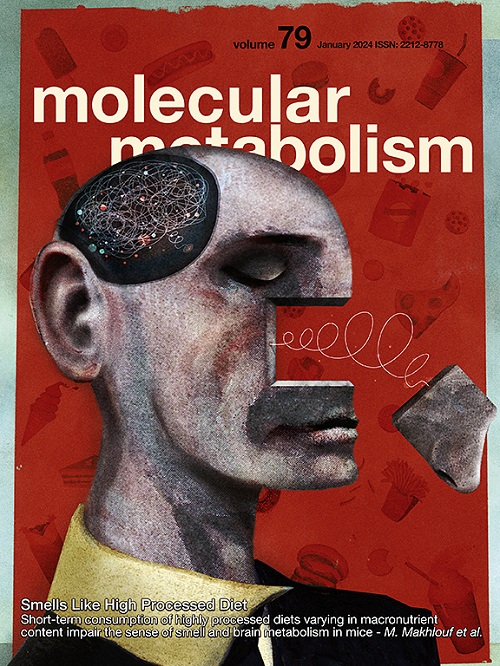高果糖通过胰高血糖素样肽 2 重构肠道葡萄糖感应,从而损害小鼠的代谢调节。
IF 7
2区 医学
Q1 ENDOCRINOLOGY & METABOLISM
引用次数: 0
摘要
本文章由计算机程序翻译,如有差异,请以英文原文为准。

High fructose rewires gut glucose sensing via glucagon-like peptide 2 to impair metabolic regulation in mice
Objective
Increased fructose consumption contributes to type 2 diabetes (T2D) and metabolic dysfunction-associated steatotic liver disease (MASLD), but the mechanisms are ill-defined. Gut nutrient sensing involves enterohormones like Glucagon-like peptide (Glp)2, which regulates the absorptive capacity of luminal nutrients. While glucose is the primary dietary energy source absorbed in the gut, it is unknown whether excess fructose alters gut glucose sensing to impair blood glucose regulation and liver homeostasis.
Methods
Mice were fed diets where carbohydrates were either entirely glucose (70 %Kcal) or glucose partially replaced with fructose (8.5 %Kcal). Glp2 receptor (Glp2r) was inhibited with Glp2 (3-33) injections. Glucose tolerance, insulin sensitivity, and gut glucose absorption were concomitantly assessed, and enteric sugar transporters and absorptive surface were quantified by RT-qPCR and histological analysis, respectively.
Results
High fructose feeding led to impairment of blood glucose disposal, ectopic fat accumulation in the liver, and hepatic (but not muscle or adipose tissue) insulin resistance independent of changes in fat mass. This was accompanied by increased gut glucose absorption, which preceded glucose intolerance and liver steatosis. Fructose upregulated glucose transporters and enlarged the gut surface, but these effects were prevented by Glp2r inhibition. Blocking Glp2r prevented fructose-induced impairments in glucose disposal and hepatic lipid handling.
Conclusion
Excess fructose impairs blood glucose and liver homeostasis by rewiring gut glucose sensing and exacerbating gut glucose absorption. Our findings are positioned to inform novel early diagnostic tools and treatments tailored to counter high fructose-induced metabolic derangements predisposing to T2D and MASLD.
求助全文
通过发布文献求助,成功后即可免费获取论文全文。
去求助
来源期刊

Molecular Metabolism
ENDOCRINOLOGY & METABOLISM-
CiteScore
14.50
自引率
2.50%
发文量
219
审稿时长
43 days
期刊介绍:
Molecular Metabolism is a leading journal dedicated to sharing groundbreaking discoveries in the field of energy homeostasis and the underlying factors of metabolic disorders. These disorders include obesity, diabetes, cardiovascular disease, and cancer. Our journal focuses on publishing research driven by hypotheses and conducted to the highest standards, aiming to provide a mechanistic understanding of energy homeostasis-related behavior, physiology, and dysfunction.
We promote interdisciplinary science, covering a broad range of approaches from molecules to humans throughout the lifespan. Our goal is to contribute to transformative research in metabolism, which has the potential to revolutionize the field. By enabling progress in the prognosis, prevention, and ultimately the cure of metabolic disorders and their long-term complications, our journal seeks to better the future of health and well-being.
 求助内容:
求助内容: 应助结果提醒方式:
应助结果提醒方式:


